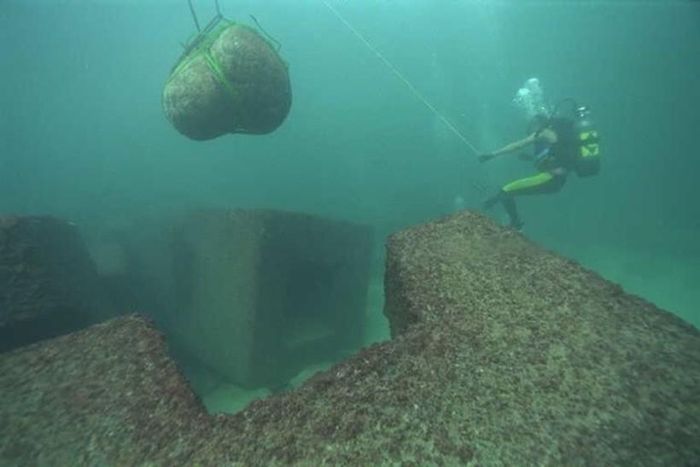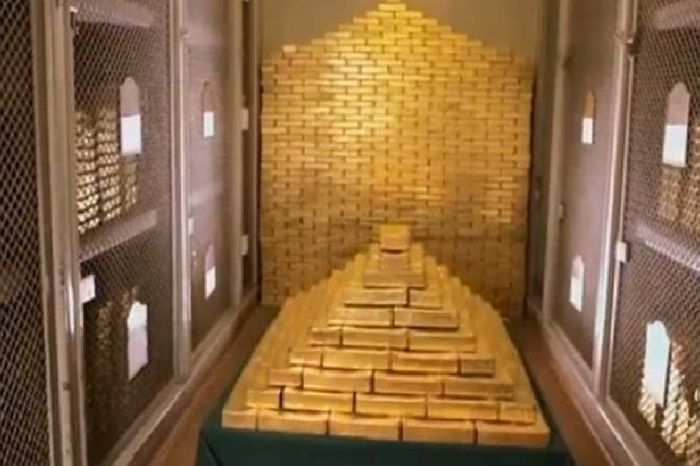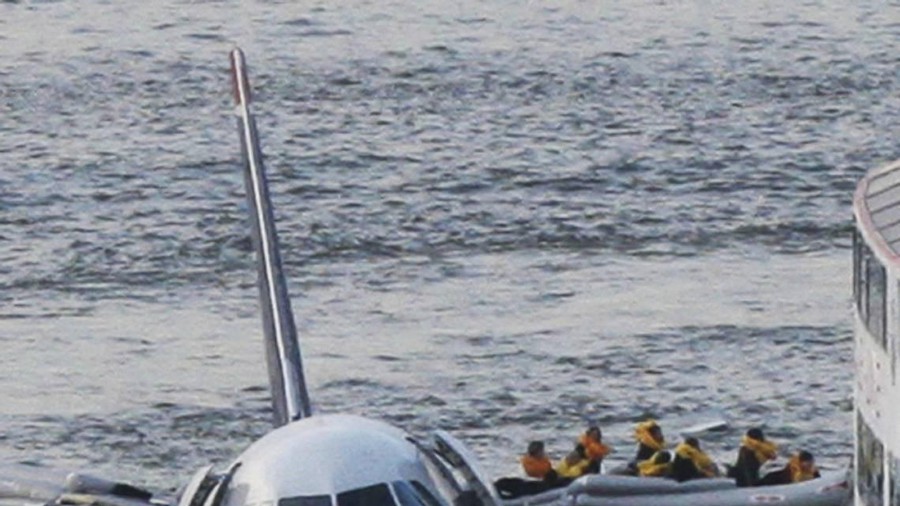What happened to the Alexandria lighthouse?

Salvaging the ruins of the world's wonder lighthouse.
However, this magnificent structure over 90 meters high eventually collapsed and today there is no trace left. Historians have searched for the cause of its disappearance and discovered many interesting things.
Magnificent project
The idea of the Alexandria lighthouse appeared around the beginning of the third century BC, when Ptolemy - a Greek general under Alexander the Great - declared himself Pharaoh of Egypt.
Built on the island of Pharos in the harbor of Alexandria, it is believed to have been designed by Sostratus of Cnidus (although he may have only been a financial backer). It is responsible for guiding the ship to shore and helping the captain avoid obstacles at night.
Although there are many different estimates, this project will take at least a decade - and possibly up to three decades - to complete. According to historians, it remained unfinished until the reign of Ptolemy II, who ruled Egypt from 284 - 246 BC.
Once completed, the Alexandria lighthouse was more than 90 meters high above the harbor and was one of the tallest man-made structures on Earth at that time. The lighthouse certainly added vitality to the port city of Alexandria, where Alexander the Great's mausoleum, the Alexandria Museum, the Serapeum and the Library of Alexandria are filled with rich knowledge about the ancient world.
In addition to its height record, the Alexandria lighthouse is also considered an architectural masterpiece. Most of what is known about its structure comes from the 20th-century German classical archaeologist Hermann Thiersch.
In his 1909 work, Pharos, antike, Islam und Occident, he described the lighthouse as being built with three floors. The lowest floor is square, the second floor is octagonal and the third floor is cylindrical.
Each level tilts slightly inward and a ramp spirals out toward the top, where there is a statue that could depict Ptolemy, Alexander the Great or some other Greek god.
Besides the always burning fire, the lighthouse is also equipped with a mirror, possibly made of bronze, to shine light out to the sea. This design helps the lighthouse to be seen from a distance of up to 50km.
Over the years, the lighthouse was repeatedly damaged by earthquakes and had to be regularly repaired, but historians' descriptions of it remained largely consistent: It was built of light-colored stone, the surface facing The sea has an inscription glorifying Zeus.
From 796 to 956, many large earthquakes occurred, causing the lighthouse to crack in some places, including the upper part, about 20 meters above the ground. Then, earthquakes and tsunamis in 1303 and 1323 destroyed much of the structure and turned it into ruins.
In 1480, the Sultan of Egypt built a fortress inside the ruins of the Alexandria lighthouse, completely erasing the remaining traces of this wonder.
Ruins of world wonders
According to preserved records, the Alexandria lighthouse first appeared on the list of world wonders in the 6th century and it was still intact in the 12th century. After being destroyed by natural disasters and wars. , it seems to be forgotten over time. It was not until the 20th century that archaeologists made an amazing discovery about this magnificent structure.
In 1916, archaeologist Gaston Jondet discovered sunken ruins in the old port of Alexandria. He described the structure in detail but unfortunately lacked archaeological evidence to determine the exact date. By 1940, Sir Leopold Halliday Savile came here to research.
Archaeologists at this time believed that there was some ancient structure in the waters off Alexandria, but did not know exactly what.
In 1968, UNESCO sponsored a survey of the old port of Alexandria led by Honor Frost, a famous archaeological expert. Frost determined that Jondet's discovery was real, even claiming that the ruins belonged to the long-lost Alexandria lighthouse. But unfortunately, the research had to be paused because the area was in conflict and occupied by the army.
It wasn't until 1994 that archaeologist Jean-Yves Empereur, founder of the Center for Alexandria Studies, rediscovered the lighthouse ruins in the waters off Pharos Island.
The Egyptian government has contracted Empereur to map and catalog anything of archaeological significance off the coast of Pharos, as it prepares to build a concrete breakwater on the site. Empereur and cinematographer Asma el-Bakri, using a 35mm camera, captured the first underwater images of the ruins of the famous lighthouse.
According to Smithsonian magazine, Empereur's team has restored many parts of the ancient lighthouse, including giant granite blocks, 30 sphinxes, five obelisks and many columns with inscriptions dating back to the ancient lighthouse. Ramses II.
In total, scientists had cataloged more than 3,300 lighthouse fragments by the end of 1995, some of which were on display in museums in Alexandria. So the Alexandria lighthouse was given life for the second time.
You should read it
- Apple acquired an important patent from AI security camera manufacturer
- The brightest man-made star in the night is about to enter the universe in July
- Top 10 geniuses with the greatest scientific invention in history
- Discover abandoned places full of ghosts in the world
- Testing computer science knowledge, doing little for fun (part 6)
- Air pollution damages millions of kidneys every year
- The beautiful short hairstyles and the most beloved sisters are today
- Offline still uses Gmail
May be interested
- Guide to Buying a Laptop - Part 2
 netbooks have been the most exciting thing that has happened to mobile computers in recent years, and also the collapse of an industry.
netbooks have been the most exciting thing that has happened to mobile computers in recent years, and also the collapse of an industry. - How to Get Your Child to Share What Happened During the Day
 to get your child comfortable sharing anything with you, it's important to show them you want to listen, and there are lots of great ways to do that.
to get your child comfortable sharing anything with you, it's important to show them you want to listen, and there are lots of great ways to do that. - Black Friday: buy Nintendo Switch on Amazon, get condoms, brushes, and rattles
 amazon said it is not sure what happened, but will investigate the issue thoroughly.
amazon said it is not sure what happened, but will investigate the issue thoroughly. - TP-Link is about to be banned in the US, what happened?
 according to a new report from the wall street journal (wsj), us authorities are planning to completely ban the sale of tp-link brand router models in the country.
according to a new report from the wall street journal (wsj), us authorities are planning to completely ban the sale of tp-link brand router models in the country. - Unexpected Instagram error deleting user account
 since last thursday, many instagram users cannot access their accounts. let's find out why this problem happened!
since last thursday, many instagram users cannot access their accounts. let's find out why this problem happened! - The Most Powerful Space Telescope Ever Built Will Look Back In Time To The Dark Ages Of The Universe
 the webb telescope will launch into orbit later this year, ushering in a new era for astronomy. the telescope will make it easy for experts to know when the first galaxies and stars were formed, which ones came first and why that happened.
the webb telescope will launch into orbit later this year, ushering in a new era for astronomy. the telescope will make it easy for experts to know when the first galaxies and stars were formed, which ones came first and why that happened. - New discoveries could make 2025 an unexpectedly happy year
 this article summarizes the good things that happened in science, which made this recent year more worthwhile, comfortable, and happier in countless ways.
this article summarizes the good things that happened in science, which made this recent year more worthwhile, comfortable, and happier in countless ways. - How to Obtain a Copy of Your High School Diploma
 it's easy to lose or damage your high school diploma. if this has happened to you, you should be able to replace it easily enough. sometimes you can get a new copy directly from your school, and other times you might have to contact a...
it's easy to lose or damage your high school diploma. if this has happened to you, you should be able to replace it easily enough. sometimes you can get a new copy directly from your school, and other times you might have to contact a... - Fix the error of missing My Computer and This PC icons on the computer screen
 what to do when we turn on the computer and lose the my computer, this pc icon on the computer's desktop screen? what happened and how to get my computer, this pc back.
what to do when we turn on the computer and lose the my computer, this pc icon on the computer's desktop screen? what happened and how to get my computer, this pc back. - 25 true photos make us mistakenly believe that it has been photoshop
 the natural moments throughout the world have happened to create hallucinations that many people think they are real.
the natural moments throughout the world have happened to create hallucinations that many people think they are real.









 Who discovered X-rays?
Who discovered X-rays? The world's largest gold vault, no bomb can destroy it
The world's largest gold vault, no bomb can destroy it The world's largest fusion reactor, as tall as 6 buildings in Japan
The world's largest fusion reactor, as tall as 6 buildings in Japan Why did the Soviets never set foot on the Moon?
Why did the Soviets never set foot on the Moon? The most exotic waterfalls in the world
The most exotic waterfalls in the world Decipher the miracle on the Hudson River 11 years ago
Decipher the miracle on the Hudson River 11 years ago